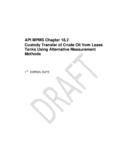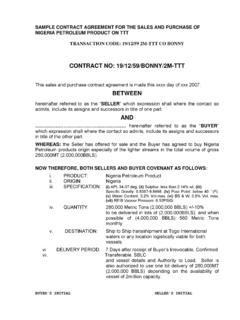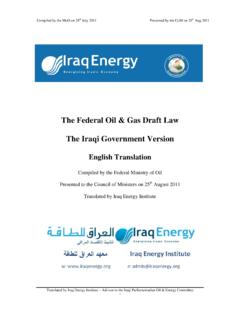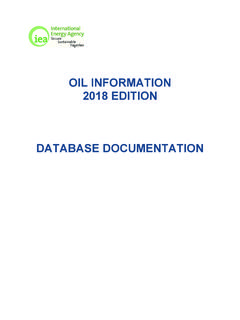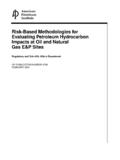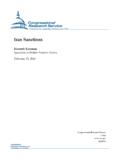Transcription of The business case for Orimulsion
1 Orimulsion IS THE BEST WAY TO MONETISE THE ORINOCO S BITUMEN (Sep Oct 2004) Introduction After almost two decades of successful development and marketing of the new and unique Venezuelan fuel for the power industry, the future of Orimulsion is unclear. PDVSA decided in August 2003 that it was dissolving Bitumenes Orinoco (BITOR) into PDVSA s eastern operating division and not expanding production of Orimulsion because it could make more profits from Venezuelan extra-heavy oil and bitumen selling blends or syncrude instead of Orimulsion . PDVSA also announced that even that it intended to fulfil long-term contracts which BITOR had with utilities in Canada, Denmark, Italy and Japan, would not sign more new Orimulsion contracts or respect contracts under negotiation in Canada, Singapore, Korea and Italy.
2 In 2004, BITOR s marketing subsidiaries in UK, USA and Italy initiated procedures to close their operations. The purpose of this article is to review the business and economic rationale of the exploitation of Orinoco Belt bitumen for the production of Orimulsion , and to evaluate the future contribution to Venezuela, its people and the world environment in general offered by this non-conventional Venezuelan resource. A perspective on the Venezuelan Extra Heavy and Bitumen hydrocarbons reserves The cost of exploiting Venezuela s non-conventional hydrocarbon reserves is lower than in Canada. Venezuela s lower costs arise largely from more favourable geological and climatic conditions. In particular, because of the reservoir characteristics, Orinoco oil can be exploited without thermal stimulation so that less energy and heat is needed to produce it.
3 The higher ambient temperatures also make the hydrocarbons easier to move and transport once extracted and results in less harsh working conditions at the oil fields. Also, Venezuela s labour and equipment costs are lower compared with those in Canada. However, Venezuela s political environment increases the country s political risk and could restrain direct foreign investment in the oil industry. Venezuela has a unique condition as the only OPEC member with major non-conventional hydrocarbon reserves; in consequence, quota treatment issues could be a factor that affects the development of these resources. Also, the need to manage and balance different sets of objectives between the Venezuela State and its National Oil Company (PDVSA), and the different International Oil Companies looking to invest in Venezuela, will define the different commercial schemes for the exploitation of Orinoco Belt.
4 The development of Venezuela s Orinoco Belt The antecedent for the exploitation of Venezuela s non-conventional hydrocarbons from the Orinoco Belt can be traced to the south of Monagas State, very near to what was later 1 known as the Cerro Negro part of the Orinoco Belt. Since 1961, Phillips Petroleum Co., Amoco, and Creole Petroleum Co (Exxon Subsidiary) developed a commercial operation for the production of the Morichal ( API), Jobo (8-9 API), Pilon (13 API) and Temblador (19 API) oil fields based at the Morichal Camp. These extra-heavy oils were produced by conventional methods including alternated steam soaking and were considered as part of Venezuela s traditional oil reserves. The Morichal and Jobo oils were diluted with gas-oil at the well head to reduce their high viscosity and facilitate their transport by pipeline and reach their sale specification as the commercial blend known as the Morichal Segregation with API, that was used to obtain the world s best asphalt.
5 Pilon and Temblador were also blended to make the Pilon Segregation with API for general refining feedstock. At present, of these two commercial crude oil segregations, PDVSA only continues the commercialisation of Pilon segregation in which all these oils are diluted to 17 API with lighter crude oils from the adjacent San Tome area and sold as blends. After the nationalisation of the Venezuelan oil industry in 1976, PDVSA s financial resources were very limited because of the under-investment by the concessionaries oil companies before the industry nationalisation, and the priority for PDVSA was the exploration and development of its conventional oil base. However, the steep rise in the price of oil caused by the Arab Oil Embargo and the Iranian Revolution, make attractive the development of the Orinoco Belt.
6 Due to the size of the area and the past involvement in different areas of the Orinoco Belt of the International Oil Companies, PDVSA divided the belt in four separate geographical areas and assigned the responsibility for the development of each one of them to one of PDVSA s subsidiaries that operated the oil production and commercialisation activities for Venezuela s hydrocarbons after the oil industry nationalisation: Cerro Negro to Lagoven , Hamaca to Meneven , Zuata to Maraven and Machete to Corpoven In the case of the Cerro Negro area, Lagoven started the development for the production of API Cerro Negro Bitumen with the start-up in 1984 of the Experimental Production Blocks J-20 and O-16 with nominal capacity for 25 thousand barrels per day (kb/d) of bitumen each one.
7 These production blocks were designed using conventional technology to test different production parameters and methods (vertical wells spacing and completion, pumping units designs, steam injection schemes, etc.) to optimise the bitumen exploitation, reduce costs, and obtain knowledge to improve the attractiveness of future developments of bitumen and extra-heavy oil from the Orinoco Belt. As in the case of Morichal and Jobo crude oils, the Cerro Negro bitumen has to be diluted with gas-oil to reduce its viscosity enough to be transported by pipeline, and it was blended and commercialised as part of the Morichal Segregation. Not always was easy to commercialise the new production of Cerro Negro bitumen in increasing quantities because of the limited world s refining capacity for processing the bitumen blends without additional investments in adapting the refineries to the new 2 feedstock, and the small size of the asphalt markets that was the prime market for the Morichal segregation.
8 The combined effect of the diluents cost (gas-oil or other lighter crude oils), the logistics costs to import them to Morichal Camp to make the blending operation, and the limited marketability for the Morichal segregation, caused that the intrinsic valorisation for Cerro Negro bitumen was poor and made the economies of the whole operation marginal, in particular under weak oil prices. As the bitumen require more amount of diluents compared with an equivalent amount of extra-heavy oil to reach the same viscosity, the limited availability and cost of the additional gas-oil deteriorated the economies of the commercial operation, in special after considering the oil price collapse in 1986-1988. This situation created adverse conditions for the development of Orinoco Belt bitumen under dilution schemes.
9 Meanwhile, during the period from 1980 to 1984, PDVSA through its Research and Development Subsidiary, Intevep , jointly with British Petroleum, executed the basic research to develop a new method to reduce the high cost of transporting bitumen by pipeline. This effort resulted in a new and simple technology to produce Cerro Negro bitumen, known as Orimulsion . In this proprietary process the bitumen is mixed with water and a surfactant chemical in order to produce a stable emulsion which can be transported by pipeline and by ship in a similar way as fuel-oil. Even better, not only the Orimulsion was easier to transport but it also can be used directly as fuel for the generation of electricity in existing thermal power plants designed for the combustion of fuel oil and/or coal, using conventional equipment with only minor modifications, with initial pricing structure competing with coal price.
10 After the initial test for the combustion of Orimulsion in 1986, at the facilities of Chubu Electric Power Corp (Mitsubishi Heavy Industries) in Japan, the development of Orimulsion continued through different pilot projects and tests using the existing facilities of Lagoven in Cerro Negro (Blocks J-20 and O-16) and Morichal Camp (oil processing facilities and residential camp), in order to define the operational parameters required to transform Orimulsion into a commercial product. Further work was carried out to understand and develop the mixing technologies, surfactant types and quantities, emulsion stability studies, and improved bitumen production methods. In 1988, PDVSA decided to initiate Orimulsion commercial operations and assigned the responsibility for its development and commercialisation to a new subsidiary: Bitumenes Orinoco with the mandate to grow a profitable business .
